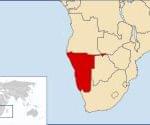Namibia is a land of great outdoors! Its rich landscapes extend as far as the eye can see and offers the curious traveler majestic red sand dunes, savannahs filled with stunning wildlife, dry riverbeds snaking through rugged mountains, vibrant colours, the oldest desert in the world bordering the Atlantic ocean and friendly local people en route. The Namibian experience invites visitors to observe a country of a grandiose and unusual nature, while they see remarkable sights and explore far away from the beaten track. We invite you to become mesmerised by the country’s charms and captivated by its magic.

To discover : Accomodation in Namibia – Routes in Namibia – Tourist activities in Namibia
The country’s wide range of different geological and geographical wonders create magnificent biodiversity. In the west, the Namib Desert, the oldest desert in the world, stretches all the way from south to north along the Atlantic coastline, and in the east of the country, the Kalahari desert reaches into Botswana and South Africa. These deserts cover around two-thirds of the country and is separated by a central plateau that reaches around 2 579 metres above sea level. In the north-east of the country, the Caprivi and Kavango offer strong contrasts to the rest of the country with lush woodlands and large perennial rivers. The diversity of these landscapes also allow for a multitude of activities: self-drive 4×4 safaris, a bird’s eye-view of the country from a light aircraft or hot air balloon, hiking, trekking, tours on horseback, boat cruises and sea kayaking… The country beckons to be explored. Along with this, with abundant fauna, it’s not unusual to see kudu, oryx and zebra wherever you go.
Namibia is bordered by the cold Atlantic Ocean to the West, an ocean rich in marine life and the center of Namibia’s fishing industry (other important industries in the country include the mining of diamonds, zinc, uranium and gold, agriculture and tourism). In the north, Namibia shares its border with Angola, Zambia and Zimbabwe, while Botswana borders the country to the east and South Africa to the south east and south. Although the country has a surface area of around 825 000 km2, it only has a little more than 2 million inhabitants and therefore has one of the world’s lowest population densities (1 person per 1.4 square kilometers). Most of the population is made up of a variety of traditional Namibian cultures and each has their own beliefs, traditions, arts and languages. The Oshiwambo is the largest group, followed by the Otjiherero, Nama, Damara, Kavango, Caprivian, Bushman, Tswana and the renowned Himba. It’s also common for these people to still live off the same land as their ancestors, in harmony with nature. The country also has a significant population of white Arikaners and Germans, as well as a large group of mixed-race people. Most of the population is concentrated in the northern area of Ovambo Land in the north of the country and in cities, especially Windhoek. The official language is English, but can be basic in some remote regions, where many local languages are more commonly spoken. Oshivambo is the most widely spoken language. The currency of Namibia is the Namibian Dollar (N$) and is on the same exchange rate as the South African Rand. South African Rand is legal tender in Namibia, but Namibian Dollar cannot be used in Namibia.
With excellent quality services, the contrast of the land, the range of emotions that it provides for visitors and the peace and stability within the country, Namibia is a remarkable destination and a land of breathtaking beauty and unique adventures. Its geographical location also allows you to extend your journey to the beautiful Victoria Falls, exciting Cape Town and the lush parks of Botswana.
In the north, Namibia has a sub-tropical climate and, in the south, has a predominantly desert climate. From one season to another, the changes in temperature can be remarkable and range from 0° C at night in winter to 40° C during the day in summer. The first part of summer is hot and dry and extends from October to December, while the second part of summer is usually the rainy season and can be quite hot and humid from January to April. Winter is cool and dry and extends from May until September. All seasons are welcoming, but the dryer winter season is more conducive to observing animals, while the rainy season offers a spectacular range of colours.
Climate
The climate is very healthy. There are 3 seasons:
- A hot dry season (the first part of the summer) from October to December;
- A hot and wet season (rainy season) from January to April;
- A cold dry season (winter) from May to September.
It can make up to 40 ° C in summer and below 0 ° C in winter’s night. There is no better period than another for travelling in Namibia. You will come in the dry season for the animals, during the rainy season for colors, and in the winter to avoid the heat.
